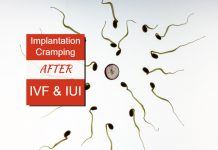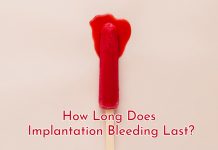What is implantation in pregnancy? Implantation is the egg embedding step that begins a pregnancy. As the egg moves in the upper layers of the uterus, it leaks blood. That is implantation bleeding which is light spotting and occurs for 1-2 days. Implantation bleeding feels like casual spotting that may even go unnoticed. Twitching cramps accompany IB that feel like gas distress.
There are many early signs of pregnancy. They include nausea and mood swings. But they overlap with the premenstrual syndrome.
The timing of implantation bleeding is nearly same as menses. Technically menses the must occur before period, but implantation can take longer.
Implantation bleeding is the spotting due to egg embedment in the lining of the uterus. The early embryo causes the shifting of blood vessels of the endometrial lining. For making space, the blood vessels leak and cause spotting.

Implantation in pregnancy: The first step of pregnancy
Implantation is what leads an egg to pregnancy. If implantation doesn’t occur then, the fertilized egg comes out with period blood.
After fertilization, the egg undergoes series of divisions called cleavage. The cells remain enveloped in the protective egg membrane.
This membrane layer hardens after entry of sperm. It is for preventing polyspermy.
The zona pellucida layer guides the egg to travel to the site of implantation. On the seventh day after conception, the egg reaches the site of implantation.
The trophoblast or animal pole area pricks the endometrial lining for egg to sink in the uterus.
The secretions from the endometrium help the egg move in. After 48 hours the egg moves in deeper layers of the uterine lining. Then it extends its chorionic villi inside the uterus for nutrition.
Placenta formation begins, and the chorion and amnion start developing.
The placenta acts as a barrier, endocrine gland, and nutrition provider for the young embryo.
What causes implantation bleeding?
After fertilization, the egg undergoes the process of cleavage (the division of egg into smaller units).
After about 3 days the zygote becomes a bunch of cells that look like a mulberry. When the divisions of fertilized egg form a 64 celled structure, it is ready for implantation.
The egg during cleavage keeps traveling down the tubes to reach the uterus. The protective layer of the egg has fibers that pierce the endometrial lining.
The egg attaches to the right site, and then the membrane dissolves leading to implantation.
How common is implantation bleeding?
Implantation bleeding occurs in about 1/3rd of pregnancies. It is normal to have spotting during pregnancy that occurs randomly.
Women irrespective of occurrence of implantation bleeding go on to have a healthy pregnancy.
The process of implantation in pregnancy is so rapid that in some cases there may be no spotting.
Pregnancy spotting due to implantation is old blood coming out. Implantation bleeding thus looks brown or dark red.
Other causes of bleeding in first three months are Placenta Previa, infections, placental abruption, and miscarriage.
How does implantation bleeding feel?
During implantation, you might feel a downward pull in your stomach. Cramps during implantation bleeding last for few hours or so.
Implantation goes unnoticed because of the mildness of symptoms. Some women may have nausea and vomiting during implantation bleeding.
Others may not even notice the difference. Vaginal discharge with blood is also a kind of implantation bleeding.
During early pregnancy the cervical mucus or vaginal discharge increases in amount.
If implantation bleeding mixes with this discharge, then you will see a bloody discharge.
The role of bloody discharge is to facilitate attachment of embryo. After egg embedment, it can derive nutrition from the mother’s body.
Excretion of waste also requires this connection. Oxygen from mother reaches the embryo through the placental connection.
How does implantation bleeding look like?
Implantation bleeding is like brown spotting. Bright red blood is not implantation spotting.
The amount of blood is also very less during implantation. Actively bleeding areas of womb give out bright red blood. It is not implantation bleeding.
The amount of blood oozing out is very less, and it lasts for only about a day or two.
If it continues for more than two days, then it may be because of other reasons.
How heavy is implantation bleeding?
Implantation is the egg embedment process. The small blastocyst cannot incur much damage to the uterus walls.
The first 12 hours go in the attachment of the egg to the uterine lining. Implantation lasts for 48 hours at most. It is a rapid process.
A heavy bleeding is not due to implantation. It is because implantation is a quick process. Any heavy bleeding cannot be implantation bleeding.
At most a woman will soak a liner in an entire day. After that, there will be no bleeding. Implantation is not a one-step process.
Nevertheless, it does not have any after effects. If the bleeding is heavy, then it is an indication that something is wrong.
Symptoms like shortness of breath, bright red bleeding, cramping and blurring of vision are signs of miscarriage. Pregnancy loss can occur during implantation. Before implantation, a woman is chemically pregnant.
After there is a test confirming hCG levels around 25 mIU/mL a woman is pregnant medically.
The early pregnancy factor is the first chemical used for the pregnancy test.
But the rate of false positive due to preimplantation failure is very high.
Heavy bleeding is a sign of miscarriage or Ectopic pregnancy. Chemical pregnancy and Molar pregnancy also cause heavy bleeding.
Implantation will not cause heavy bleeding.




![Implantation Bleeding With Twins [How long does IB last with twins?] Implantation Bleeding With Twins](https://www.pregnanteve.com/wp-content/uploads/2019/01/implantation-bleeding-with-twins-218x150.jpg)




